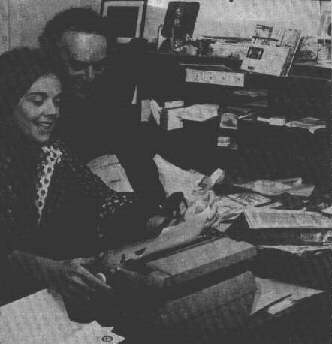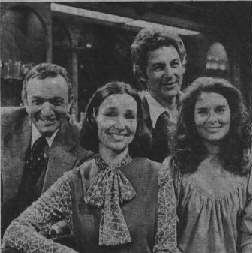Head Writer Claire Labine
Celebrates Ryan's Hope
Daytimers, 1982
by Joanna Coons
Article Provided By Sabrina

Claire teamed with Paul Mayer for
Love is a Many Splendored Thing,
Love of Life and development of Ryan's
Hope. Only recently, because Paul
wants to do other things, have they split.The writing career of Ryan’s Hope co-creator and headwriter, Claire Labine, began in New York City—New York that is, via Jacksonville, Florida and Louisville, Kentucky. “I was born in Jacksonville but grew up all over the midwest and went to high school and began college in Louisville,” Labine says, her large hazel-green eyes wide with animation. In fact, after a year and a half as a journalism major at the University of Kentucky, the writer discovered her real love was the theater and took off for New York’s Columbia University’s School of Dramatic Arts, where, she recalls whimsically: “It took me about 20 minutes to realize that the market for six foot ingénues—that’s me—was severely limited.”
Not one to be discouraged, though, Labine changed her major to playwriting and the rest is one huge success story.
Each weekday, Claire Labine, through those wonderful “Ryans” enters the homes and hearts of nearly six million Americans. The responsibility accompanying that realization is, for the writer, an awesome one. “I am very aware of the responsibility,” she says soberly. “I do try to touch my audience.” With storylines that steer away from the sensational, Ryan’s Hope has become synonymous with the family with its generational conflicts. “All those things about families—parents and children—those are the parts of the show that I love the best; things about compassion and love and what it can do to you in good ways and in bad ways.”
Ryan’s Hope, Labine says with a nurturing pride, is about a set of characters who celebrate the human condition. “We have not always been able to remain true to that,” she explains, “because relentless celebration is not dramatic.” But she is quick to point out that her characters do not whine. “Even ‘Delia’ at her most upset does not whine, and none of them wring their hands and say, ‘Oh dear, what am I going to do?’”
Her women, particularly, are strong, vital, functioning human beings in their own right. Do they perhaps overshadow the male characters in the show? “I’m told that they do,” Labine says. “But it’s not deliberate and I’m sorry if they do.” At that moment, the writer flashes a Brontesque smile. “You see, I think it’s pretty hard to overshadow Michael Levin (“Jack Fenelli”). He’s really my Heathcliff!”
Would “Maeve Ryan” vote for ERA? Labine does not hesitate to reply: “Oh sure she would, because I don’t really think ERA is against the home and I don’t know what all the fuss about it is.” The truth of this statement is nowhere better seen than in Claire Labine herself. Married to editor-publisher Clem Labine since 1958, Claire unabashedly admits: “What I wanted to do was to have my babies, raise them by myself and be with them when they were little and then write whenever I could write. And I wouldn’t have done it any differently.” Her marriage and her children, she emphasizes, had a tremendous influence on what Claire Labine, the writer, was to become, and on what she is still in the process of becoming. “I still haven’t grown up,” she laughs.
Although most of her experience has been in soaps, Labine plunged into feature films in 1979, writing and producing a re-telling of the medieval classic, Tristan and Isolde, starring Richard Burton and Kate Mulgrew, whom audiences will remember as the original “Mary Ryan” on RH. Shot on location in Ireland, the film is due to go into general release this year.
Not bad for a lady whose professional writing career began in 1966 as a script writer for none other than Captain Kangaroo! Noting the inherent humor in the assignment, Labine relates that her agent called one morning inquiring whether she had ever heard of the popular kiddie program. “Well, I almost fell on the floor laughing,” she says, trying to remain serious but breaking up regardless. “I said, ‘Yes, I have; as a matter of fact, we just turned it off about an hour ago!’” Well, before she could say “Peter Rabbit,” Labine’s was the proud pen behind the beloved voices of “Moose” and “Bunny Rabbit.” Eleanor, her middle child, she teases, used to write jokes for the show. “She had a real grasp of the material,” the writer laughs.
After a year and a half with the Captain, Labine was fired. “I have no idea why. But a lot of people were fired and I was so sad…I did not want to leave my ‘Moose’ and my ‘Bunny Rabbit’!” Parenthetically, she adds, “I also hate rejection!”
But almost immediately, Claire Labine made her debut in soap opera. With an ingeniousness so typical of her, she says, “The only one I’d ever watched was Love of Life, which I’d turn on while I sat down to nurse a baby.” Nonetheless, Labine proved such a quick study that she was hired to write a CBS soaper called Where the Heart Is. It was there the now famous Labine-Mayer partner ship was born. They continued until the show’s demise in 1973. The team moved to Love of Life as headwriters and stayed until 1975, when Ryan’s Hope was born.
“We started the development of Ryan’s Hope right after the writer’s strike in ’73, after which it went on the air—to my astonishment!” Labine confides. In fact, for the first few years, both Labine and Mayer were walking a figurative tightrope. “We were so afraid it was going to be cancelled.” Claire Labine pauses, no doubt reflecting on the show’s subsequent accolades: the Emmys, the universal acclaim, the expectations.
Indeed, for Labine, Ryan’s Hope has been a labor of love. About the characters, the writer says: “I love every one of them. I love the old ones more than the new ones because I’ve lived with them longer.” Are the characters based on real-life people? “Partly,” Claire admits, “’Maeve’ is part my mother, part my grandmother (who used to sing her all the Irish revolutionary songs), and part everybody’s mother. ‘Johnny’ is a combination of many people. ‘Mary Ryan’ (the show’s original heroine) was named after my best friend in the whole world, Mary Ryan Munisteri, who is one of our dialogue writers as well as the show’s creative consultant. ‘Delia’ is based on one of the most stunning neurotics I’ve ever known in my life, who must remain nameless…I could go on and on,” she beams, like a proud parent, showing off her child’s report card. “When I leave it, I want to feel I’ve left it in good hands.”That Ryan’s Hope has always stressed the nuclear family is no accident. As Labine sees it, the family unit provides the human psyche with the great need to survive. “I think mutual support within a family is one of the great gifts of life and that’s why it’s a part of the show.” Indeed, when the time comes, it will be very difficult for Claire Labine to leave her made-up family.
When asked what broke up the Labine-Mayer partnership, the writer replies, “Time. Paul wanted to do other things. He really didn’t want to wait. We’re still friends, though,” she stresses. That Labine chose to remain with the show until her contract expires in 1983 is hardly surprising. Not one to let go of anything easily, Clair (sic) observes: “I wasn’t ready to leave Ryan’s Hope yet. I felt as if there was still a lot to do and the torch was not in very good shape to be passed.” She pauses reflectively.
Observing that Ryan’s Hope is the most different of the TV soaps, the writer comments that it is the quality of the acting, the writing, and the dedication and aspirations of all those involved with the show that take it beyond the label, “soap opera.”
“The term soap opera doesn’t bother me,” Labine states emphatically. But, she points out, “I hate and I resent the terrible suppositions being made about the quality of the work based on the form.” For the first time during the interview, her eyes flash indignation. “It makes me madder than hell because no one in that studio does one easy thing. There is nothing glib. Our writers do not write a script in a day.”
To wit, Labine’s own dedication is nothing short of amazing. Usually getting by with three to five hours of sleep a night, she not only devises the show’s storyline, but with two associate writers, outlines each day’s episode and usually writes on script herself per week.
How does she do it? “I love it,” she says very genuinely, as though somehow that should explain everything. Strangely enough, with Claire Labine, it does.
Love and celebration—they are the theme, the emotion, the experience, the keywords in the script of her world. They are Ryan’s Hope.

Bernie Barrow, Helen Gallagher,
Nancy Addison Altman (Goldfarb)
and John Gabriel are original cast.

Early in the "lets get stars
on soaps" craze, RH managed
to land Chris Reeve in a guest
spot. He's ex-Love of Live.